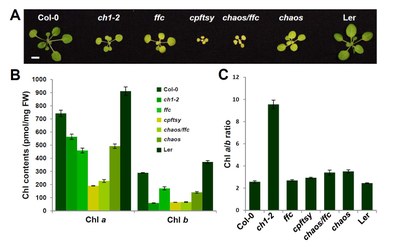Coordination between tetrapyrrole biosynthesis and chloroplast SRP pathway
Peng Wang
In the biogenesis of light-harvesting chlorophyll-binding proteins (LHCPs), the chloroplast signal recognition particle (cpSRP) machinery post-translationally functions in the targeting and integration of LHC apo-proteins into the thylakoid membrane. Imported LHCPs are recognized by the chloroplast-specific cpSRP43, which recruits cpSRP54 to form a transit complex in the stroma. The cpSRP43-LHCP-cpSRP54 complex migrates to the stromal side of thylakoid membrane and interacts with the SRP receptor cpFtsY and the cpSRP translocase ALB3. Upon GTP hydrolysis, which is catalyzed by GTPase activity of cpSRP54 and cpFtsY, LHCPs is ultimately folded and integrated into the thylakoid membranes via ALB3.
Chlorophyll is required for the proper folding and stable incorporation of LHCPs into thylakoid membrane. It is the goal of our studies to unravel the mode of action how chlorophyll is assembled into LHCPs within the cpSRP pathway. Potential roles of cpSRP components are hypothesized for the synchronized coordination of the LHCP translocation to the thylakoid membranes and the control of chlorophyll biosynthesis (Wang and Grimm 2015). The connection between tetrapyrrole metabolism and LHCP assembly into the thylakoid membranes will be explored by means of Arabidopsis mutants for each of the cpSRP components (Figure 1) and biochemical and genetic approaches to prove the protein-protein interactions. To the end, it is expected to unveil novel connections of functional cpSRP components to chlorophyll synthesis as well as for the integration of chlorophyll into LHCPs.

Figure 1.Characterization of chlorina and cpSRP-deficient mutants.
- 18-days-old wild type (Col-0 and Ler) seedlings, chlorina1-2 (ch1-2, lacking chlorophyll a oxygenase) and multiple cpsrp mutants (ffc, a cpSRP54 deficient mutant; cpftsy, lacking the SRP receptor; chaos, a cpSRP43 deficient mutant )
- Chlorophyll (Chl) contents in the above plants
- Chl a/b ratios in the above plants